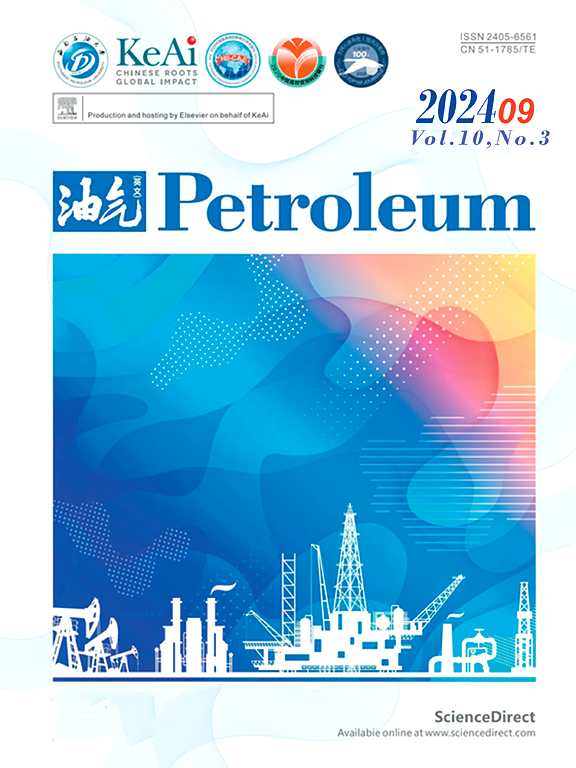Experimental and modelling studies on static sag of solid weighting powders in Polysulfonate workover fluids at high temperature and high pressure
IF 4.2
Q2 ENERGY & FUELS
引用次数: 0
Abstract
The solid weighting material in a high-density workover fluid is prone to static sag. Existing experimental methods cannot predict the parameters of the settling stability of workover fluids at high temperature and high pressure (HTHP). Therefore, in this study, static settlement experiments were carried out using a novel experimental setup. The experimental setup enables the measurement of the density profile of heavy workover fluids at HTHP. A multi-parameter correlation equation between the sag factor and particle diameter, particle density, base fluid density, workover fluid density and rheological parameters, aging time, temperature, and pressure was obtained using dimensional analysis and multivariate nonlinear regression methods. The results reveal that the settlement stability of the workover fluid decreases with the increase in temperature and pressure. Based on the multi-parameter correlation, the predicted and the measured values were compared and verified. The error between the predicted value and the measured value was within 5%. The average prediction error was 1.68%, and the maximum prediction error was 3.8%. These results reveal that the model proposed in this study can effectively predict the static sedimentation stability of the solid weighted Polysulfonate workover fluids. Furthermore, the proposed correlation can guide the properties adjustment of the workover fluids to achieve the required sag stability. This work provides a new approach to predict and control the sag stability of the solid weighted workover fluids.
高温高压下固体加重粉在聚磺酸修井液中静态沉降的实验与模型研究
高密度修井液中的固体加重材料容易产生静态凹陷。现有的实验方法无法预测修井液在高温高压下的沉降稳定性参数。因此,本研究采用一种新颖的实验装置进行静力沉降试验。该实验装置能够测量高温高压下重修井液的密度分布。采用量纲分析和多元非线性回归方法,得到了沉降系数与颗粒直径、颗粒密度、基液密度、修井液密度、流变参数、时效时间、温度和压力之间的多参数相关方程。结果表明,随着温度和压力的升高,修井液的沉降稳定性降低。基于多参数相关性,对预测值和实测值进行了比较和验证。预测值与实测值误差在5%以内。平均预测误差为1.68%,最大预测误差为3.8%。结果表明,该模型能够有效预测固体加权聚磺酸盐修井液的静沉降稳定性。此外,所提出的相关性可以指导修井液的性质调整,以达到所需的凹陷稳定性。这项工作为固体加重修井液的沉降稳定性预测和控制提供了一种新的方法。
本文章由计算机程序翻译,如有差异,请以英文原文为准。
求助全文
约1分钟内获得全文
求助全文
来源期刊

Petroleum
Earth and Planetary Sciences-Geology
CiteScore
9.20
自引率
0.00%
发文量
76
审稿时长
124 days
期刊介绍:
Examples of appropriate topical areas that will be considered include the following: 1.comprehensive research on oil and gas reservoir (reservoir geology): -geological basis of oil and gas reservoirs -reservoir geochemistry -reservoir formation mechanism -reservoir identification methods and techniques 2.kinetics of oil and gas basins and analyses of potential oil and gas resources: -fine description factors of hydrocarbon accumulation -mechanism analysis on recovery and dynamic accumulation process -relationship between accumulation factors and the accumulation process -analysis of oil and gas potential resource 3.theories and methods for complex reservoir geophysical prospecting: -geophysical basis of deep geologic structures and background of hydrocarbon occurrence -geophysical prediction of deep and complex reservoirs -physical test analyses and numerical simulations of reservoir rocks -anisotropic medium seismic imaging theory and new technology for multiwave seismic exploration -o theories and methods for reservoir fluid geophysical identification and prediction 4.theories, methods, technology, and design for complex reservoir development: -reservoir percolation theory and application technology -field development theories and methods -theory and technology for enhancing recovery efficiency 5.working liquid for oil and gas wells and reservoir protection technology: -working chemicals and mechanics for oil and gas wells -reservoir protection technology 6.new techniques and technologies for oil and gas drilling and production: -under-balanced drilling/gas drilling -special-track well drilling -cementing and completion of oil and gas wells -engineering safety applications for oil and gas wells -new technology of fracture acidizing
 求助内容:
求助内容: 应助结果提醒方式:
应助结果提醒方式:


